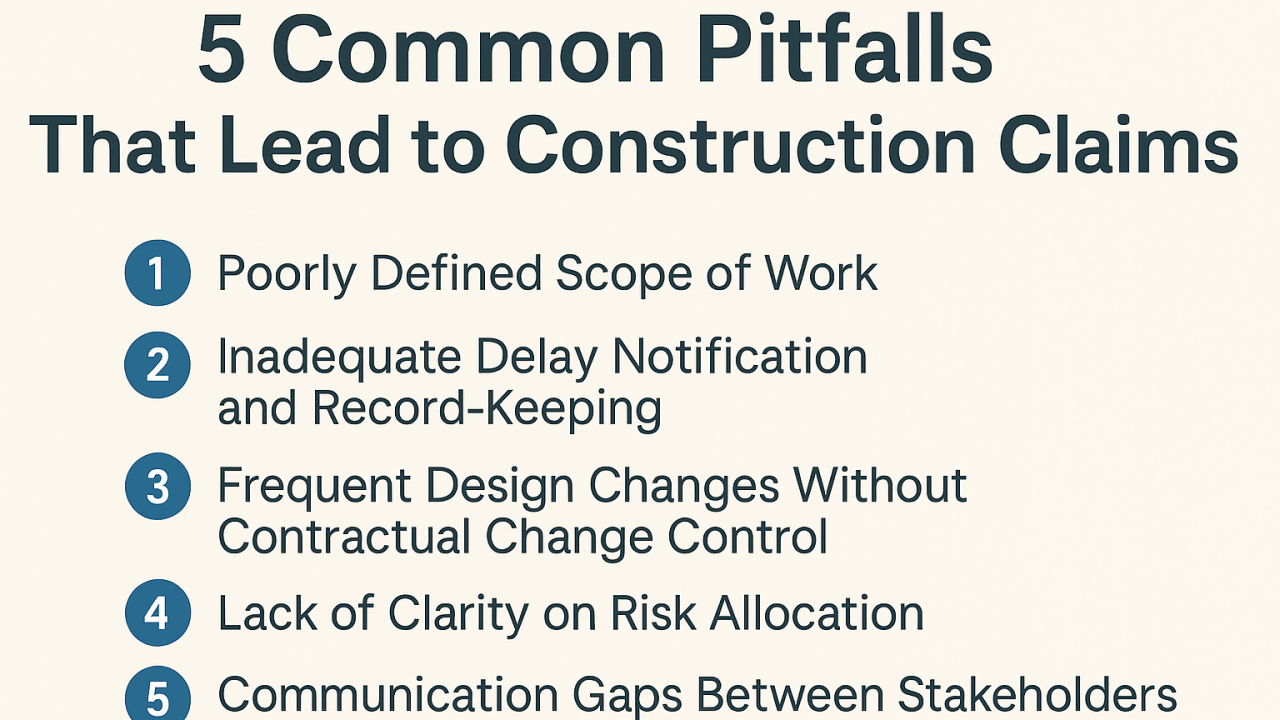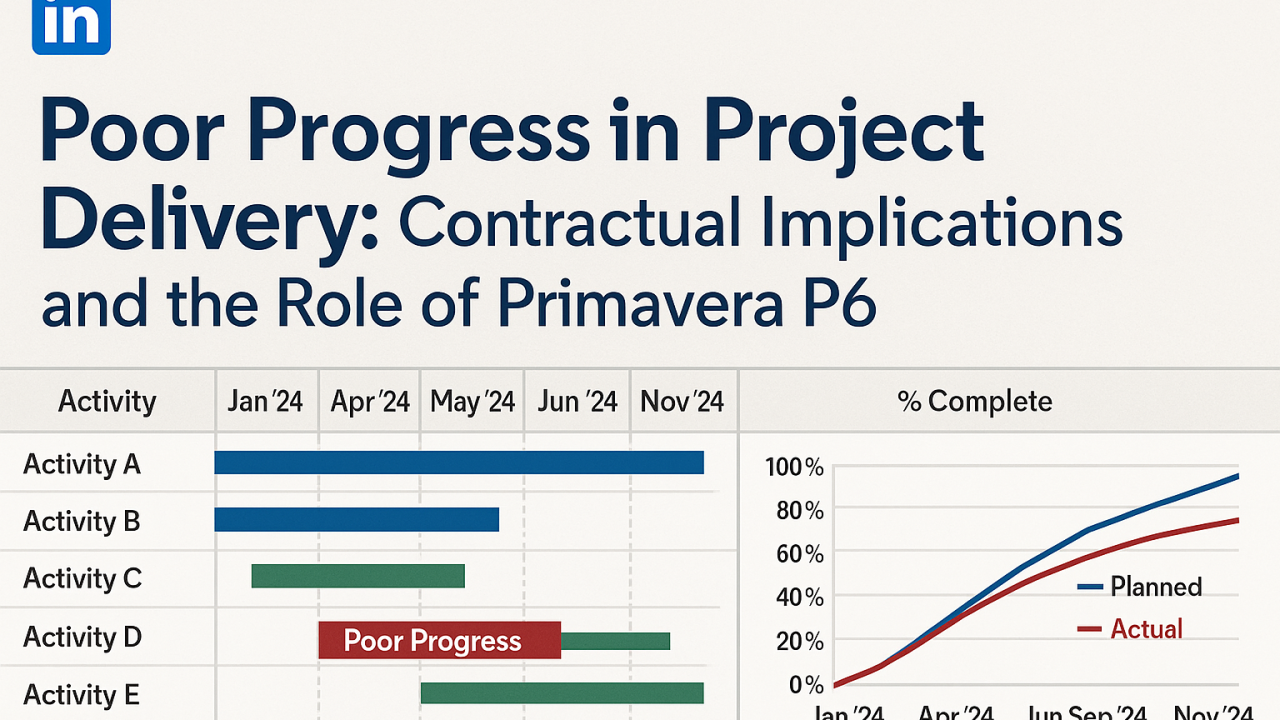5 Common Pitfalls That Lead to Construction Claims
Introduction :
In complex construction projects, claims are not merely a risk — they are often an inevitability. Whether arising from scope creep, delays, or miscommunication, claims can disrupt project delivery, increase costs, and strain relationships between stakeholders.
This article outlines five key pitfalls that frequently lead to claims in construction contracts, along with practical advice on how to avoid them. The insights below draw on principles commonly taught in leading MSc programs in Construction Law & Dispute Resolution, such as at King’s College London, and align with international contracting standards like FIDIC and NEC.

1. Poorly Defined Scope of Work
Why it causes problems: An ambiguous or incomplete scope often leads to divergent interpretations of contractual obligations. Contractors may assume certain tasks are included, while the employer sees them as extras — triggering variation claims.
Real-world scenario: A contractor starts foundation work assuming site clearing is included. The employer, however, treats it as a separate billable item. The result? A delay and a claim for additional payment.
How to prevent it:
- Ensure the scope of work is defined in precise, technical terms.
- Use Work Breakdown Structures (WBS) and BOQ itemization to avoid overlap.
- Include explicit exclusions in tender documentation.
2. Inadequate Delay Notification and Record-Keeping
Why it causes problems: Most standard form contracts (e.g., FIDIC Clause 20) require timely notification of delay events. Failure to notify within the stipulated window often leads to rejection of claims — regardless of their merit.
Real-world scenario: Heavy rains delay site access for 2 weeks, but the contractor notifies the engineer 21 days later — breaching the 14-day notice period. The entitlement to an extension of time is lost.
How to prevent it:
- Implement a real-time site diary system.
- Train site managers to flag potential delay events immediately.
- Automate contractual deadline alerts via scheduling software.
3. Frequent Design Changes Without Contractual Change Control
Why it causes problems: Frequent or informal design changes lead to scope creep. When not managed through formal Variation Orders, they create disputes about compensation and liability for time impacts.
Real-world scenario: An architect provides hand-drawn sketches for a revised façade without going through a formal instruction. The contractor proceeds, later claims costs, and the employer disputes the validity.
How to prevent it:
- Adhere strictly to change management procedures (e.g., FIDIC Clause 13).
- All instructions should be issued in writing and authorized by the Engineer/PM.
- Keep a log of all changes with time and cost implications assessed in advance.
4. Lack of Clarity on Risk Allocation
Why it causes problems: Disputes often arise when contracts do not clearly assign responsibility for specific risks (e.g., unforeseen ground conditions, material price escalation).
Real-world scenario: A contractor encounters rock during excavation but the contract remains silent on subsurface risks. The employer refuses compensation, citing fixed-price terms.
How to prevent it:
- Use risk matrices in pre-contract negotiation to define ownership of key risks.
- Reference geotechnical baseline reports and include “Differing Site Conditions” clauses.
- Allocate risks to the party best positioned to control or insure against them.
5. Communication Gaps Between Stakeholders
Why it causes problems: Misalignment between project participants — contractor, client, consultants — can escalate misunderstandings into claims, especially in multinational or joint venture contexts.
Real-world scenario: A joint venture partner assumes that local standards apply, but the client expects full compliance with Eurocodes. Conflicting assumptions lead to non-compliant execution and costly rework.
How to prevent it:
- Conduct regular multidisciplinary coordination meetings.
- Develop a project execution plan that harmonizes expectations and standards.
- Establish a single point of communication for instructions and change approvals.
Final Thoughts
Construction claims are often symptomatic of deeper project management or contractual deficiencies. By focusing on proactive contract administration — from accurate scoping to disciplined change control — stakeholders can mitigate risk and maintain project momentum.
For professionals and students entering the field of construction law and dispute resolution, mastering these foundational principles is not optional — it’s essential. The ability to anticipate and manage claims is increasingly seen as a core skill, not just for legal advisors, but for all key actors in the project lifecycle.
Nos derniers articles
Poor Progress in Project Delivery: Contractual Implications and the Role of Primavera P6
Poor Progress in Project Delivery: Contractual Implications and the Role of Primavera P6 Introduction : In complex projects—especially in engineering,…
Effective Management of Float in Project Scheduling: Definition, Legal Aspects, Technical Application, and Tools
Effective Management of Float in Project Scheduling: Definition, Legal Aspects, Technical Application, and Tools 1. Introduction : In project management,…
5 Common Pitfalls That Lead to Construction Claims
5 Common Pitfalls That Lead to Construction Claims Introduction : In complex construction projects, claims are not merely a risk…



